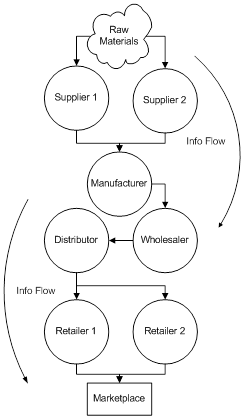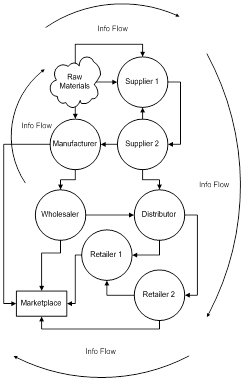This article is an excerpt from the Total Financial Network (TFN) white paper by Christopher Vincent titled Value Chain Networking. Download the entire white paper in pdf format HERE.
This is Part 2 – Return to the Introduction
Understanding the Value Chain
As touched on earlier understanding the make-up of a company’s Value Chain via Value Stream Mapping or a similar exercise is a critical activity. Not only understanding the internal structure but how the company fits into the Value Chain of the industry or sector also becomes necessary.
This critical issue is truly identifying the company’s core value added activity in the eyes of their customer.
This can be further broken down however and be used at the group, campaign or product level. This is not always possible though and at times a more loosely defined approach as seen in the Value Network Analysis is needed.
From Wikipedia on fast-track complex process redesign…
“Product and service offerings are constantly changing – and so are the processes to innovate, design, manufacture, and deliver them. Multiple, inter-dependent, and concurrent processes are too complex for traditional process mapping, but can be analyzed very quickly with the value network method.”
A relevant real world example of this is how customer interacts on a company’s social media sites. A company may have a process for how they delivery content to their followers, however managing the response to this content and the tangential questions or comments that arise may be too loose and require a more free-flowing process to implement effectively.
Impact of the Value Network
The effect of belonging to multiple Value Networks changes actions and behaviors of individuals and business on a daily basis rather they know it or not. A lesser known fact is that Value Networks can breed negative results. As seen for individuals via social pressures, guilt and mob mentality. Business can get stuck into micro-economies or loose the organized structures to be cost effective and timely for their customers.

Traditional Supply Chain
By and large however when utilized and understood correctly Value Networks become a huge positive for all parties involved. This is evident in phenomena such as “group buying” and other voice of the customer communities. Online forums and social media have allowed Value Networks of consumers and activities to get together and communicate more effectively back to producers and suppliers in the same or congruent over-arching Value Network.
For businesses it affords peace of mind and ease of business transactions. Also, by formalizing agreements it drives costs down between organizations and allows for a decrease in forecast error along the supply chain.
For example a customer may have a group of suppliers that they routinely order supplies from. By formalizing these arrangements and guaranteeing volume it allows both parties to enjoy lowers costs and smoother day to day transactions. This is standard purchasing and logistics practice in supply chain management. The importance of the Value Network, is that when relationships and business networking is leveraged it allows for more parties to benefit from the collective whole.
In the traditional approach both product and informational flows in one direction and process gaps or errors are more likely. Untimeliness of delivery and feedback is also an issue with this traditional setup.

Value Network Approach
With the Value Network approach there is more connectivity and better information flow across the supply chain. Products can also get to the customer faster and in unfinished or aftermarket formats directly from entities higher up in the chain.
An example of this type of approach is very evident in the world of personal computing with manufacturers like Intel and Microsoft and/or distributors like Dell taking more of a focal role in the industry Value Chain.
The customer also has a louder voice in the second example. With information age technology and communication platforms such as social media it allows in many cases the customer to take center stage in the Value Network and be a contributing member to product development via an open feedback loop.






 Speak To A Specialist -
Speak To A Specialist -